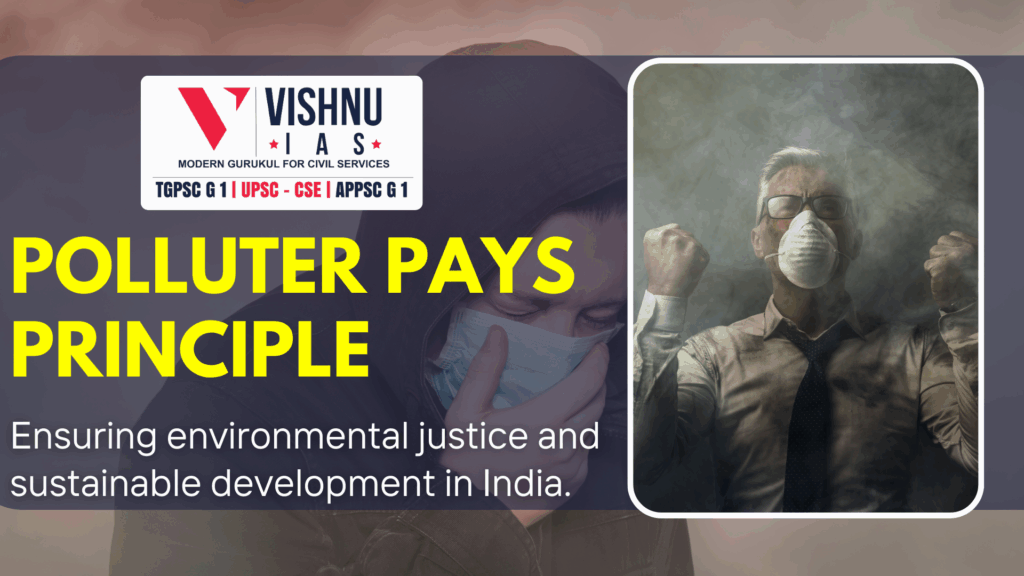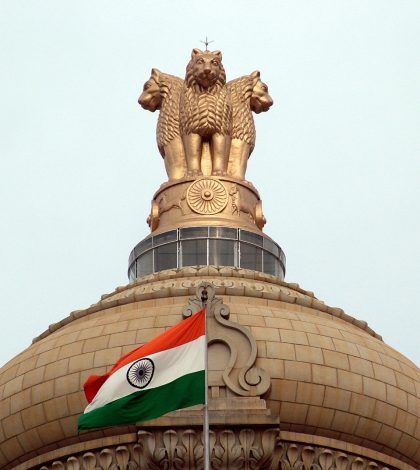Q. Critically analyse the effectiveness of the "Polluter Pays Principle" in ensuring environmental justice and sustainable development in India.
Introduction:
- The Polluter Pays Principle (PPP) is a foundational tenet of environmental law that mandates that those who cause environmental degradation bear the costs of managing it. In India, this principle has been enshrined in legal frameworks and judicial pronouncements, notably under Article 21 of the Constitution, which guarantees the right to life and a healthy environment. The National Green Tribunal Act, 2010, further institutionalized PPP, empowering the National Green Tribunal (NGT) to adjudicate environmental disputes and enforce penalties on polluters.
- Despite these legal provisions, challenges persist in effectively implementing PPP to ensure environmental justice and sustainable development. India’s environmental landscape is marred by issues such as inadequate waste management, industrial pollution, and lack of accountability, underscoring the need for a critical analysis of PPP’s effectiveness
Body:
Legal and Institutional Framework
Judicial Recognition and Enforcement
- Vellore Citizens Welfare Forum v. Union of India (1996): The Supreme Court recognized PPP and the Precautionary Principle as integral to environmental jurisprudence, holding tanneries in Tamil Nadu liable for polluting the Palar River and mandating compensation and ecological restoration.
- Kodaikanal Mercury Contamination Case: Hindustan Unilever’s thermometer factory was found to have caused mercury pollution in Kodaikanal. Public protests and legal actions led to the factory’s closure and eventual remediation efforts.
- Plachimada Coca-Cola Case: Coca-Cola’s bottling plant in Kerala was accused of depleting groundwater and contaminating local water sources. Although the plant was shut down following protests, compensation to affected villagers remains pending.
Role of the National Green Tribunal (NGT)
- Establishment and Mandate: The NGT was established under the National Green Tribunal Act, 2010, to provide expeditious environmental justice and enforce PPP. It has jurisdiction over cases related to environmental protection and conservation of forests and natural resources.
- Case Example: In 2021, the NGT upheld a penalty of ₹57.96 lakhs imposed on NTPC for environmental damage in Uttarakhand, reinforcing the application of PPP.
- Challenges: The NGT faces issues such as understaffing and limited resources, which hinder its ability to effectively enforce environmental laws.
Legislative Provisions
- Environmental Laws: Key legislations like the Environment (Protection) Act, 1986, Water (Prevention and Control of Pollution) Act, 1974, and Air (Prevention and Control of Pollution) Act, 1981, incorporate PPP by holding polluters accountable for environmental harm.
- Extended Producer Responsibility (EPR): Under the Plastic Waste Management Rules, producers are mandated to manage the end-of-life disposal of plastic products, aligning with PPP.
Government Initiatives
- Swachh Bharat Mission: Aims to improve waste management and sanitation, indirectly supporting PPP by promoting responsible waste disposal.
- National Action Plan on Climate Change (NAPCC): Includes missions that encourage sustainable practices and hold industries accountable for emissions, reflecting PPP principles.
Implementation Challenges
Inadequate Data and Monitoring
- Underreporting of Waste: Studies indicate that India’s official plastic waste generation figures are underestimated, with rural areas and informal sectors often excluded from data collection.
- Lack of Methodology Transparency: The methodologies adopted by State Pollution Control Boards (SPCBs) and municipal bodies for data collection are not publicly disclosed, leading to questions about data reliability.
- Absence of Geotagging: Waste management infrastructure is not geotagged, making it difficult to track and manage waste effectively.
Enforcement and Compliance Issues
- Delayed Compensation: In cases like Plachimada, despite clear evidence of environmental harm, affected communities have not received due compensation, highlighting enforcement gaps.
- Continued Pollution: Industries often continue polluting activities due to lax enforcement and lack of stringent penalties.
- Judicial Backlogs: Environmental cases often face delays in courts, undermining the deterrent effect of PPP.
Institutional Limitations
- Resource Constraints: Regulatory bodies like the NGT and SPCBs often operate with limited resources and manpower, affecting their ability to monitor and enforce environmental regulations.
- Coordination Challenges: Lack of coordination among various government agencies hampers effective implementation of PPP.
- Limited Public Participation: Communities often lack awareness and avenues to participate in environmental decision-making processes.
Socio-Economic Factors
- Informal Sector Exclusion: Informal waste pickers play a significant role in waste management but are often excluded from formal systems, leading to inefficiencies.
- Economic Pressures: Industries may prioritize economic gains over environmental compliance, especially in the absence of strict enforcement.
- Public Awareness: Limited public awareness about environmental rights and PPP hampers community-driven accountability.
Pathways to Strengthen PPP Implementation
Enhancing Legal and Institutional Frameworks
- Strengthening NGT: Addressing staffing and resource shortages in the NGT can improve its capacity to adjudicate cases effectively.
- Transparent Methodologies: SPCBs and municipal bodies should adopt and disclose standardized methodologies for data collection and reporting.
- Regular Audits: Conducting regular environmental audits can ensure compliance and identify areas needing intervention.
Leveraging Technology
- Geotagging Infrastructure: Implementing geotagging for waste management facilities can enhance tracking and accountability.
- Digital Platforms: Developing digital platforms for waste tracking and public reporting can increase transparency.
- Data Analytics: Utilizing data analytics can help in predicting pollution trends and formulating proactive measures.
Community Engagement and Awareness
- Public Participation: Encouraging community involvement in environmental decision-making can lead to more effective outcomes.
- Awareness Campaigns: Educational initiatives can inform citizens about their environmental rights and responsibilities.
- Supporting Informal Workers: Integrating informal waste workers into formal systems can enhance efficiency and provide them with better livelihoods.
Economic Instruments and Incentives
- Pollution Taxes: Implementing taxes on pollution can serve as a deterrent and generate funds for environmental restoration.
- Subsidies for Clean Technologies: Providing financial incentives for adopting environmentally friendly technologies can encourage compliance.
- Green Certifications: Recognizing and rewarding industries that adhere to environmental standards can promote best practices.
Conclusion:
- The Polluter Pays Principle is a vital instrument in India’s quest for environmental justice and sustainable development. While legal frameworks and institutional mechanisms exist to enforce PPP, challenges in implementation, enforcement, and public participation persist. Addressing these issues requires a multifaceted approach involving legal reforms, technological advancements, community engagement, and economic incentives. By strengthening the application of PPP, India can move towards a more sustainable and equitable environmental future.


